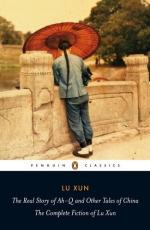|
This section contains 3,865 words (approx. 13 pages at 300 words per page) |

|
SOURCE: "Lusin's 'Ah Q': A Rejected Image of Chinese Character," in The Pacific Spectator, Vol. 10, No. 2, Spring, 1956, pp. 137-46.
In the essay below, Weakland discusses the significance of Ah Q as a symbol of Chinese national character.
Modern Chinese fiction, which is often sharply critical of traditional Chinese patterns of living, offers valuable insight into what is rejected in past culture and character and also into imagined or envisioned counter-images for future realization. This, in turn, mirrors some of the qualities of the political character of the people. From a casual investigation, the literary and, by extension, political image of what should be rejected is much clearer and more prominent than is any image of an ideal to be achieved.
Since fiction is richer and more easily analyzed than directly political writings, "Our Story of Ah Q" by Lusin in Ah Q and Others (translated by C. C...
|
This section contains 3,865 words (approx. 13 pages at 300 words per page) |

|


